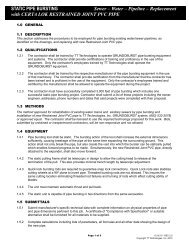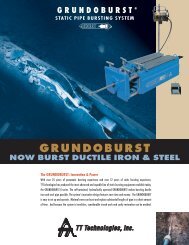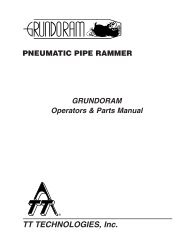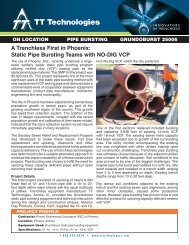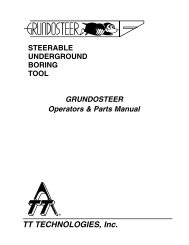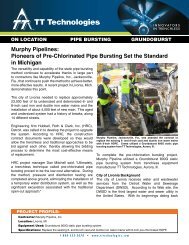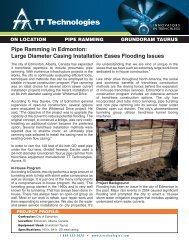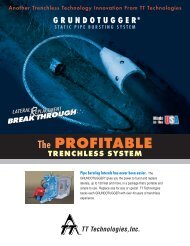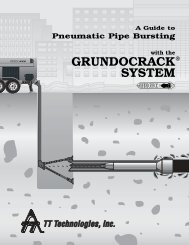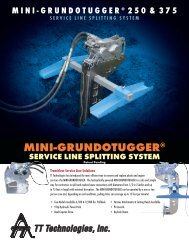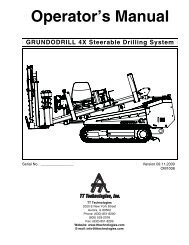Pipe Ramming in the Thin Air: BTrenchless Goes Large Diameter
Pipe Ramming in the Thin Air: BTrenchless Goes Large Diameter
Pipe Ramming in the Thin Air: BTrenchless Goes Large Diameter
Create successful ePaper yourself
Turn your PDF publications into a flip-book with our unique Google optimized e-Paper software.
I N N O V A T O R S<br />
IN TRENCHLESS<br />
ON LOCATION PIPE RAMMING GRUNDORAM TAURUS<br />
<strong>Pipe</strong> <strong>Ramm<strong>in</strong>g</strong> <strong>in</strong> <strong>the</strong> Th<strong>in</strong> <strong>Air</strong>:<br />
<strong>BTrenchless</strong> <strong>Goes</strong> <strong>Large</strong> <strong>Diameter</strong><br />
Pneumatic pipe ramm<strong>in</strong>g cont<strong>in</strong>ues to prove that it is one<br />
of <strong>the</strong> most versatile and effective trenchless methods.<br />
With much of <strong>the</strong> attention be<strong>in</strong>g placed on pipe<br />
ramm<strong>in</strong>g’s effectiveness for assist<strong>in</strong>g directional drill<strong>in</strong>g<br />
operations, it is easy to overlook pipe ramm<strong>in</strong>g <strong>in</strong> its<br />
more traditional role of cas<strong>in</strong>g <strong>in</strong>stallation. <strong>BTrenchless</strong><br />
(a division of BT Construction), Henderson, Colo.<br />
recently showed just how effective pipe ramm<strong>in</strong>g can<br />
be for large diameter cas<strong>in</strong>g work.<br />
Accord<strong>in</strong>g to Mark Wellensiek, <strong>BTrenchless</strong> Bor<strong>in</strong>g<br />
General Super<strong>in</strong>tendent, <strong>the</strong> company has progressed<br />
from smaller diameter pipe rams to tackl<strong>in</strong>g large<br />
diameter projects. He said, “We’ve done about six<br />
pipe rams so far. We started with 24-<strong>in</strong>ch and 30-<strong>in</strong>ch<br />
diameter cas<strong>in</strong>gs, <strong>the</strong>n completed several 42-<strong>in</strong>ch<br />
diameters and worked our way up to this 84-<strong>in</strong>ch ram.”<br />
For <strong>the</strong> 84-<strong>in</strong>ch diameter, 80-foot pipe ram under<br />
Highway 160 <strong>in</strong> Pagosa Spr<strong>in</strong>gs, Colo., <strong>BTrenchless</strong><br />
used a 24-<strong>in</strong>ch diameter Grundoram Taurus pneumatic<br />
pipe rammer from trenchless equipment manufacturer<br />
TT Technologies, Aurora, Ill.<br />
to successfully<br />
c o m p l e t e<br />
projects on time<br />
and on budget.<br />
The company’s<br />
t r e n c h l e s s<br />
c a p a b i l i t i e s<br />
i n c l u d e :<br />
microtunnel<strong>in</strong>g<br />
tunnel bor<strong>in</strong>g,<br />
hand tunnel<strong>in</strong>g,<br />
guided (pilot<br />
tube) auger<br />
b o r i n g ,<br />
h o r i z o n t a l<br />
auger bor<strong>in</strong>g,<br />
pipe ramm<strong>in</strong>g,<br />
h o r i z o n t a l<br />
d i r e c t i o n a l<br />
drill<strong>in</strong>g, pipe<br />
r e a m i n g<br />
and vacuum<br />
excavation.<br />
For <strong>the</strong> 84-<strong>in</strong>ch diameter, 80-foot pipe ram<br />
under Highway 160 <strong>in</strong> Pagosa Spr<strong>in</strong>gs,<br />
Colo., <strong>BTrenchless</strong> used a 24-<strong>in</strong>ch diameter<br />
Grundoram Taurus pneumatic pipe rammer.<br />
Company Background<br />
<strong>BTrenchless</strong> is one of Colorado’s largest trenchless<br />
contractors, offer<strong>in</strong>g a variety of trenchless construction<br />
techniques for utility system <strong>in</strong>stallations and<br />
replacement of water, storm, and sanitary sewer l<strong>in</strong>es<br />
and conduits. As a division of BT Construction, Inc.,<br />
<strong>BTrenchless</strong> has over 25 years of utility construction<br />
experience. By ma<strong>in</strong>ta<strong>in</strong><strong>in</strong>g a large <strong>in</strong>ventory of<br />
equipment and employ<strong>in</strong>g a large number of skilled<br />
professionals, <strong>BTrenchless</strong> has <strong>the</strong> resources necessary<br />
The project <strong>in</strong> Pagosa Spr<strong>in</strong>gs drew heavily on <strong>the</strong><br />
company’s construction experience and trenchless<br />
expertise.<br />
Project Background<br />
Accord<strong>in</strong>g to Wellensiek, <strong>the</strong> orig<strong>in</strong>al CMP multi-plate<br />
culvert <strong>in</strong>stalled <strong>in</strong> 1958 had collapsed. In addition, a<br />
s<strong>in</strong>khole was develop<strong>in</strong>g on <strong>the</strong> nor<strong>the</strong>ast side of <strong>the</strong><br />
<strong>in</strong>tersection of US 160 and 8 th Street. The dra<strong>in</strong>age<br />
cas<strong>in</strong>g is part of a larger dra<strong>in</strong>age system that directs<br />
PROJECT PROFILE:<br />
Contractor: <strong>BTrenchless</strong><br />
Location: Pagosa Spr<strong>in</strong>gs, CO<br />
Equipment Used: Grundoram Taurus pneumatic pipe rammer<br />
Specifications: For <strong>the</strong> 84-<strong>in</strong>ch diameter, 80-foot pipe ram under Highway 160<br />
1 - 8 0 0 - 5 3 3 - 2 0 7 8 • w w w . t t t e c h n o l o g i e s . c o m
un-off from <strong>the</strong> San Juan Mounta<strong>in</strong> Range, through<br />
town of Pagosa Spr<strong>in</strong>gs and <strong>in</strong>to <strong>the</strong> San Juan River.<br />
Cont<strong>in</strong>uous flow through <strong>the</strong> culvert has made <strong>the</strong><br />
s<strong>in</strong>khole a significant problem. The edge of <strong>the</strong> s<strong>in</strong>khole<br />
was only 25 feet from <strong>the</strong> north shoulder of west bound<br />
US 160 and <strong>the</strong> portion of <strong>the</strong> exist<strong>in</strong>g culvert under<br />
Highway 160 was so deteriorated that <strong>the</strong> Colorado<br />
Dept. of Transportation (CDOT) determ<strong>in</strong>ed that <strong>the</strong><br />
pipe needed to be replaced.<br />
with repeated percussive blows. A cutt<strong>in</strong>g shoe is often<br />
welded to <strong>the</strong> front of <strong>the</strong> lead cas<strong>in</strong>g to help reduce<br />
friction and cut through <strong>the</strong> soil. Bentonite or polymer<br />
lubrication can also be used to help reduce friction<br />
dur<strong>in</strong>g ramm<strong>in</strong>g operations. <strong>Ramm<strong>in</strong>g</strong> tools, <strong>in</strong> general,<br />
are capable of <strong>in</strong>stall<strong>in</strong>g 4- through 147-<strong>in</strong>ch diameter<br />
pipe and steel cas<strong>in</strong>gs.<br />
<strong>Ramm<strong>in</strong>g</strong> can be used for horizontal, vertical, and even<br />
angled applications. It is often used under roads, like<br />
<strong>the</strong> Pagosa project, and rail l<strong>in</strong>es because it displaces<br />
<strong>the</strong> soil without creat<strong>in</strong>g voids or slumps.<br />
Accord<strong>in</strong>g to TT Technologies pipe ramm<strong>in</strong>g specialist<br />
Rick Melv<strong>in</strong> that is a key benefit of pipe ramm<strong>in</strong>g. He<br />
said, “Some <strong>in</strong>stallation methods can jeopardize <strong>the</strong><br />
<strong>in</strong>tegrity of roads or rail l<strong>in</strong>es because <strong>the</strong>y remove soil<br />
from underneath to allow for <strong>the</strong> new pipe <strong>in</strong>stallation.<br />
<strong>Pipe</strong> ramm<strong>in</strong>g’s ability to <strong>in</strong>stall various sized cas<strong>in</strong>gs<br />
without putt<strong>in</strong>g <strong>the</strong> topside structures <strong>in</strong> danger makes<br />
it a very attractive option. Also pipe ramm<strong>in</strong>g works <strong>in</strong><br />
difficult soil conditions. Boulders and rocks, as large as<br />
<strong>the</strong> cas<strong>in</strong>g itself, can be swallowed up as <strong>the</strong> cas<strong>in</strong>g<br />
moves through <strong>the</strong> soil and can be removed after <strong>the</strong><br />
<strong>in</strong>stallation is complete.”<br />
Dur<strong>in</strong>g <strong>the</strong> pipe ramm<strong>in</strong>g process, a pneumatic hammer is attached to<br />
<strong>the</strong> rear of <strong>the</strong> cas<strong>in</strong>g or pipe.<br />
Wellensiek said, “As <strong>the</strong> ma<strong>in</strong> artery between Pagosa<br />
Spr<strong>in</strong>gs and Durango, Colo, Highway160 is a very busy<br />
two lane highway and CDOT did not want to impact<br />
traffic by open cutt<strong>in</strong>g <strong>the</strong> highway to <strong>in</strong>stall a new<br />
culvert. Open cutt<strong>in</strong>g was really never an option. We<br />
would have had to perform that type of work late at<br />
night when traffic levels were as low as possible.”<br />
Ultimately, plans were drawn up to ram an 84-<strong>in</strong>ch<br />
diameter steel cas<strong>in</strong>g over <strong>the</strong> deteriorat<strong>in</strong>g 60-<strong>in</strong>ch<br />
CMP culvert and encase it. The exist<strong>in</strong>g CMP would<br />
<strong>the</strong>n be removed from <strong>the</strong> steel cas<strong>in</strong>g and a new 60-<br />
<strong>in</strong>ch RCP l<strong>in</strong>e <strong>in</strong>stalled. The <strong>BTrenchless</strong> crew would<br />
face many challenges <strong>in</strong> order to make that happen.<br />
<strong>Pipe</strong> <strong>Ramm<strong>in</strong>g</strong> 101<br />
Dur<strong>in</strong>g <strong>the</strong> pipe ramm<strong>in</strong>g process, a pneumatic<br />
hammer is attached to <strong>the</strong> rear of <strong>the</strong> cas<strong>in</strong>g or pipe.<br />
The ramm<strong>in</strong>g tool, which consists of a piston with<strong>in</strong> a<br />
cas<strong>in</strong>g, drives <strong>the</strong> pipe or cas<strong>in</strong>g through <strong>the</strong> ground<br />
An entire length of pipe can be <strong>in</strong>stalled at once or,<br />
for longer runs, one section at a time can be <strong>in</strong>stalled.<br />
In that case, <strong>the</strong> ramm<strong>in</strong>g tool is removed after each<br />
section is <strong>in</strong> place and a new section is welded on to <strong>the</strong><br />
end of <strong>the</strong> newly <strong>in</strong>stalled section. The ramm<strong>in</strong>g tool is<br />
connected to <strong>the</strong> new section and ramm<strong>in</strong>g cont<strong>in</strong>ues.<br />
Several methods can be used to remove spoil from <strong>the</strong><br />
cas<strong>in</strong>g <strong>in</strong>clud<strong>in</strong>g compressed air, water, an augur<strong>in</strong>g<br />
system or o<strong>the</strong>r types of earthmov<strong>in</strong>g equipment.<br />
High and Not So Dry<br />
One of <strong>the</strong> first challenges Wellensiek and <strong>the</strong><br />
<strong>BTrenchless</strong> crew faced was elevation. Wellensiek said,<br />
“Pagosa Spr<strong>in</strong>gs sits at an elevation of 7,100 feet above<br />
sea level. That has a direct impact on <strong>the</strong> capacity of<br />
your air compressor system.”<br />
Ano<strong>the</strong>r difficult aspect of <strong>the</strong> project was ma<strong>in</strong>ta<strong>in</strong><strong>in</strong>g<br />
dra<strong>in</strong>age flow through <strong>the</strong> exist<strong>in</strong>g culvert while<br />
ramm<strong>in</strong>g. Wellensiek said, “At times <strong>the</strong>re was really<br />
low flow. Twice dur<strong>in</strong>g this project we were completely<br />
flooded out because of ra<strong>in</strong> and <strong>the</strong>re was no way to<br />
handle that amount of water. So basically we stopped,<br />
and got out of <strong>the</strong> way. There was noth<strong>in</strong>g else we<br />
could do.”<br />
On <strong>the</strong> Job<br />
<strong>BTrenchless</strong> crews excavated a ramm<strong>in</strong>g pit on <strong>the</strong><br />
1 - 8 0 0 - 5 3 3 - 2 0 7 8 • w w w . t t t e c h n o l o g i e s . c o m
south side of <strong>the</strong> road and prepared a ramm<strong>in</strong>g pad<br />
by layer<strong>in</strong>g approximately 18 <strong>in</strong>ches of <strong>in</strong>ch-and-a-half<br />
rock <strong>in</strong> <strong>the</strong> bottom of <strong>the</strong> pit. Once complete crews<br />
assembled <strong>the</strong> 60-<strong>in</strong>ch jack and bor<strong>in</strong>g mach<strong>in</strong>e. The<br />
rails of <strong>the</strong> mach<strong>in</strong>e were used to support and guide <strong>the</strong><br />
new 84-<strong>in</strong>ch cas<strong>in</strong>g dur<strong>in</strong>g <strong>the</strong> pipe ramm<strong>in</strong>g process.<br />
Once <strong>the</strong> cas<strong>in</strong>g was placed <strong>in</strong> position, crews made<br />
<strong>the</strong> connection between <strong>the</strong> 84-<strong>in</strong>ch cas<strong>in</strong>g and <strong>the</strong> 24-<br />
<strong>in</strong>ch pie rammer. Melv<strong>in</strong> expla<strong>in</strong>ed, “The connection<br />
between <strong>the</strong> tool and <strong>the</strong> cas<strong>in</strong>g is made through a<br />
tapered ram cone and 84-<strong>in</strong>ch cotter segments. This<br />
configuration ensures that <strong>the</strong> maximum driv<strong>in</strong>g force<br />
is transferred to <strong>the</strong> pipe. In <strong>the</strong> past, ramm<strong>in</strong>g a cas<strong>in</strong>g<br />
of this diameter would have required a fabricated<br />
ramm<strong>in</strong>g adapter, but as <strong>the</strong> demand for larger and<br />
large diameter ramm<strong>in</strong>g equipment has <strong>in</strong>creased, we<br />
(TT Technologies) now offer standard ramm<strong>in</strong>g gear for<br />
cas<strong>in</strong>g diameters as large as 96 <strong>in</strong>ches. This saves<br />
time and money for <strong>the</strong> contractor.”<br />
Accord<strong>in</strong>g to Wellensiek, remov<strong>in</strong>g <strong>the</strong> exist<strong>in</strong>g CMP<br />
pipe was a challenge once <strong>the</strong> ramm<strong>in</strong>g was complete.<br />
He said, “When <strong>the</strong> new cas<strong>in</strong>g was hammered over<br />
an exist<strong>in</strong>g pipe we encountered some 30-<strong>in</strong>ch m<strong>in</strong>us<br />
rock dur<strong>in</strong>g <strong>the</strong> process. These rocks were pushed<br />
<strong>in</strong>to <strong>the</strong> exist<strong>in</strong>g CMP. In addition, as <strong>the</strong> cas<strong>in</strong>g was<br />
hammered, <strong>the</strong> ground was compressed around <strong>the</strong><br />
exist<strong>in</strong>g CMP multi plate. We needed use an acetylene<br />
torch to cut <strong>the</strong> CMP <strong>in</strong>to 10-foot sections. Then, we<br />
pulled out those sections with <strong>the</strong> bor<strong>in</strong>g mach<strong>in</strong>e.”<br />
After <strong>the</strong> old CMP pipe was removed and all <strong>the</strong> spoil<br />
cleaned out, <strong>the</strong> new 60-<strong>in</strong>ch RCP culvert was jacked<br />
<strong>in</strong>to place. Fly ash was used to fill <strong>the</strong> annular between<br />
<strong>the</strong> new 60-<strong>in</strong>ch pipe and <strong>the</strong> 84-<strong>in</strong>ch cas<strong>in</strong>g.<br />
Wellensiek was impressed with <strong>the</strong> results. He said,<br />
“I was really pleasantly surprised that that 84-<strong>in</strong>ch<br />
cas<strong>in</strong>g went across <strong>the</strong>re as quickly as it did. The real<br />
challeng<strong>in</strong>g part was ma<strong>in</strong>ta<strong>in</strong><strong>in</strong>g <strong>the</strong> water flow through<br />
<strong>the</strong>re. But now that we’ve gotten through that, we know<br />
we’d be able to do it aga<strong>in</strong>.”<br />
Melv<strong>in</strong> said, “The <strong>BTrenchless</strong> crew really did a great<br />
job on this project. It was very challeng<strong>in</strong>g from start<br />
to f<strong>in</strong>ish, but <strong>the</strong>se guys know what <strong>the</strong>y’re do<strong>in</strong>g and<br />
do it well.”<br />
Jim Schill<br />
Technical Writer<br />
Mankato, MN<br />
2020 E New York Street • Aurora, IL 60502 • 1-800-533-2078 • 1-630-851-8200 • FAX 1-630-851-8299<br />
www.tttechnologies.com • E-mail <strong>in</strong>fo@tttechnologies.com<br />
Copyright© 2007, TT Technologies, Inc.<br />
GRUNDORAM is a registered<br />
trademark of TT Technologies, Inc.<br />
Specifications subject to change at any time.



